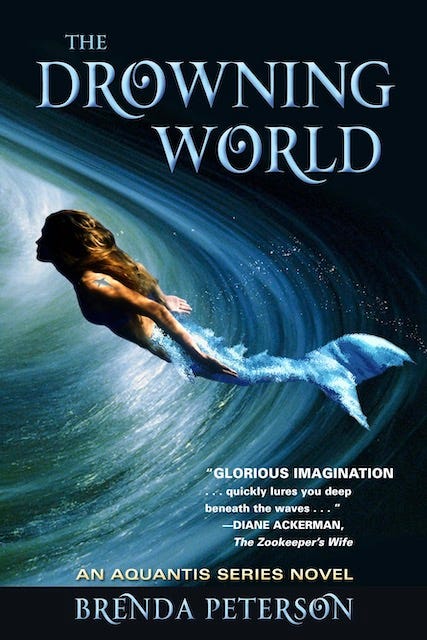Little Mermaid and Climate Change
Will we all soon be “UNDER THE SEA?”
Why are we vividly imagining so many underwater worlds and advanced civilizations? Could it be because our own world is drowning?
Disney’s new “Little Mermaid,” “Avatar: The Way of Water,” and “Wakanda Forever” are not set on earth as we know it, but in astonishing watery realms. Is this because we are preparing for an amphibious future?
In “The Little Mermaid,” Ariel again sheds her gorgeous tail fins and voice for human love, but she is also evolved into a savvy and beautiful Black girl; In “Avatar,” Jake Sully has also evolved into a “former human,” trying again to save Pandora, a culturally rich, underwater universe; and in “Wakanda Forever,” a rare “heart-shaped herb” gives superhuman abilities and hopeful healing. There is progress in our myth-making. And lessons.
Could it be that these epic water world stories are teaching us how to navigate a future of climate change? Will we learn to adapt to rising seas, environmental refugees, and floating cities? Stories often envision the future and help us change our ways. These three popular films are not only fascinating stories, they are also a blueprint for a Homo Sapiens species that must evolve or go extinct—like the Neanderthals who just couldn’t change and learn a new way of surviving.
In 2012, as a nature writer and novelist, I published some of the first cli-fi (climate-fiction) novels, The Drowning World and the sequel Tattoo Master. This Aquantis series is set in a future of tsunamis, Flood Lands, and characters who are half-dolphin, half-human. The Aquantas are an advanced underwater civilization helping humans evolve as our lands sink into the sea.
Of course, since The Drowning World is YA/crossover, there is a love story between between human boy and mer-girl, as well as shape-shifting. It is young people who are on the vanguard of climate change activism as all generations face what kids call “global weirding.” Unlike the main warrior plots in “Avatar” and “Wakanda Forever,” The Drowning World is not a dystopian book; it is about learning to adapt to our own drastically changing water world. The young mermaid, Marina, who beaches on a flooded Siesta Key, Florida in 2040, must learn to shift into land legs and pass as human—to save both our world and hers.

“Shifting is always painful. My tail flukes glittered and shook free from the thousands of tinkling silver scales. My backbone hummed as my dorsal fin folded neatly, hidden against my spine. Heat lightning slashed like a laser up through my tail flukes and ripped my lovely tail in two. My fins unfurled into feet with ten wobbly toes. Weirdly cool toenails. Maybe I would paint them. I wiggled my new, long legs. It was strangely exciting to walk on the earth, to try to fit in, to finally find out who I really am.”
In my water world series, Marina meets a human boy, Lukas, whom she must teach and transform. Unlike Ariel in “The Little Mermaid,” who loses her voice, her tail flukes, her identity—it is the humans in The Drowning World who must change and adapt to the oceans. What would be more timely than two people from an underwater cosmos and our world trying to find love together? Mermaid and human. Every taboo or prejudice that we experience in inter-racial or interfaith love is explored and magnified.
When I first imagined The Drowning World, submerged coastlines seemed decades away. But now we are enduring atmospheric rivers, hurricanes, floods and “thousand-year weather events,” all seasons. Sometimes the extremes on the Weather Channel seem more like science fiction than fact.
We have inland floods in Yellowstone and Yosemite; in Italy, ten thousand people were recently left homeless after record rainfall; Venice is now an underwater city; fish swim down main streets in Miami; whole countries, like Jakarta, are trying to figure out how to move to higher ground.
So why wouldn’t our blockbuster films now also take place in water worlds? “I want to be where the people are,” Ariel sings. “Up where they walk, up where they stay all day in the sun. Wish I could be part of that world.” But isn’t the subliminal 21st century message now exactly opposite? Instead of a mermaid longing to be on land, aren’t we all mesmerized by life underwater? Wish we could part of that water world, indeed.
In “Avatar: The Way of Water,” there are so many battles, it’s almost like “Star Wars” under the sea, though less militaristic because of the peaceful culture of Pandora. Some of the actors, like Sigourney Weaver, had to learn how to free-dive for the film, with so many scenes filmed underwater. In “Wakanda Forever,” there is also warfare, with CIA and FBI enemies; but more emphasis on the indigenous culture of Talokan, an ancient underwater realm based on Atlantis and Aztec mythoilogy. These water worlds are richly imagined and often much more inviting than the ruined earth, stricken with pollution, devastation, and endless war.
Wish we could part of that water world, indeed.
Like Disney’s earlier water world film, Moana, an island and indigenous culture are also endangered by climate change.“ Moana shows how the issues of native lifestyles and climate change are inextricably bound up with one another; how indigenous peoples are among those most impacted by global warming,” an Earth Island Journal review explains.
What all these cinematic water worlds are reminding us is that our ocean-encircled planet belongs most to the seas, not us land dwellers. We must learn how to adapt to those rising, sometimes raging, always sustaining seas—dive deep into our own imaginations, our diverse cultures, our inventions to survive. It’s not really about war; it’s about a sea change.
So why not turn our full attention to oceans, our first and last womb? Why not learn to shape shift? Because now our real world really is drowning. And as Jake Sully assures the Reef people whose lives are the sea.
“We will adapt.”
Bio: Brenda Peterson is the author of more than twenty books. Her writing has appeared in the New York Times, Chicago Tribune, Seattle Times, and Oprah magazine. Her novel, Duck and Cover, was a New York Times “Notable Book of the Year” and her new novel, Stiletto, a mystery, is out this month. Peterson lives in Seattle on the Salish Sea. More excerpts from The Drowning World to come on Medium. The audiobook will be out this summer. www.BrendaPetersonBoooks.com
